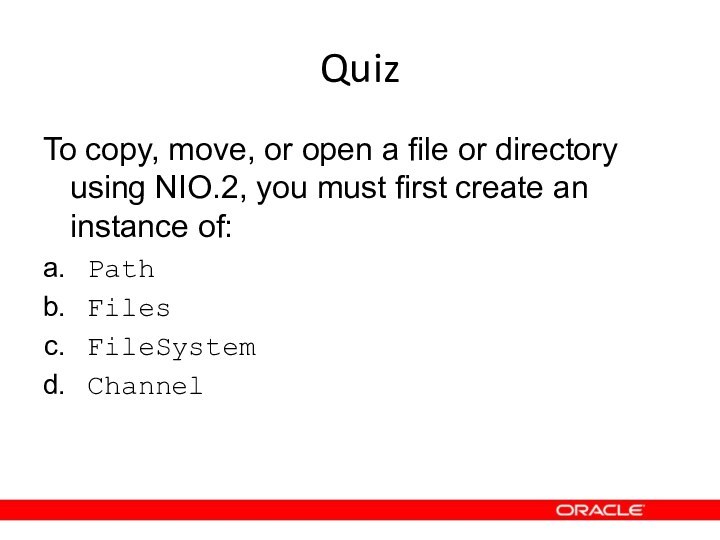Слайд 2
Objectives
After completing this lesson, you should be able
to:
Use the Path interface to operate on file and
directory paths
Use the Files class to check, delete, copy, or move a file or directory
Use Files class methods to read and write files using channel I/O and stream I/O
Read and change file and directory attributes
Recursively access a directory tree
Find a file by using the
PathMatcher class
Слайд 4
Limitations of java.io.File
Does not work well with symbolic
links
Very limited set of
file attributes
Performance issues
Scalability
issues
Very basic file system access functionality
Слайд 5
File Systems, Paths, Files
In NIO.2, both files and
directories are represented by a path, which is the
relative or absolute location of the file or directory.
root node:
/ (Solaris)
C:\ (Windows)
Admin
Documents and Settings
labs
student
finance.xls
logfile.txt
Слайд 6
Relative Path Versus Absolute Path
A path is either
relative or absolute.
An absolute path always contains the root
element and the complete directory list required to locate the file.
Example:
A relative path must be combined with another path in order to access a file.
Example:
...
/home/peter/statusReport
...
...
clarence/foo
...
Слайд 8
Java NIO.2 Concepts
Prior to JDK 7, the java.io.File
class was the entry point for all file and
directory operations. With NIO.2, there is a new package and classes:
java.nio.file.Path: Locates a file or a directory by using a system-dependent path
java.nio.file.Files: Using a Path, performs operations on files and directories
java.nio.file.FileSystem: Provides an interface to a file system and a factory for creating a Path and other objects that access a file system
All the methods that access the file system throw IOException or a subclass.
Слайд 9
Path Interface
The java.nio.file.Path interface provides the entry point
for the NIO.2 file and directory manipulation.
To obtain a
Path object, obtain an instance of the default file system, and then invoke the getPath method:
FileSystem fs = FileSystems.getDefault();
Path p1 = fs.getPath ("D:\\labs\\resources\\myFile.txt");
The java.nio.file package also provides a static final helper class called Paths to perform getDefault:
Path p1 = Paths.get ("D:\\labs\\resources\\myFile.txt");
Path p2 = Paths.get ("D:", "labs", "resources", "myFile.txt");
Path p3 = Paths.get ("/temp/foo");
Path p4 = Paths.get (URI.create ("file:///~/somefile");
Escaped backward slash
Слайд 10
Path Interface Features
The Path interface defines the methods
used to locate a file or a directory in
a file system. These methods include:
To access the components of a path:
getFileName, getParent, getRoot, getNameCount
To operate on a path:
normalize, toUri, toAbsolutePath, subpath, resolve, relativize
To compare paths:
startsWith, endsWith, equals
Слайд 11
Path: Example
public class PathTest
public
static void main(String[] args) {
Path p1 = Paths.get(args[0]);
System.out.format("getFileName: %s%n", p1.getFileName());
System.out.format("getParent: %s%n", p1.getParent());
System.out.format("getNameCount: %d%n", p1.getNameCount());
System.out.format("getRoot: %s%n", p1.getRoot());
System.out.format("isAbsolute: %b%n", p1.isAbsolute());
System.out.format("toAbsolutePath: %s%n", p1.toAbsolutePath());
System.out.format("toURI: %s%n", p1.toUri());
}
}
java PathTest D:/Temp/Foo/file1.txt
getFileName: file1.txt
getParent: D:\Temp\Foo
getNameCount: 3
getRoot: D:\
isAbsolute: true
toAbsolutePath: D:\Temp\Foo\file1.txt
toURI: file:///D:/Temp/Foo/file1.txt
Run on a Windows machine. Note that except in a cmd shell, forward and backward slashes are legal.
Слайд 12
Removing Redundancies from a Path
Many file systems use
“.” notation to denote the current directory and “..”
to denote the parent directory.
The following examples both include redundancies:
The normalize method removes any redundant elements, which includes any “.” or “directory/..” occurrences.
Example:
/home/./clarence/foo
/home/peter/../clarence/foo
Path p = Paths.get("/home/peter/../clarence/foo");
Path normalizedPath = p.normalize();
/home/clarence/foo
Слайд 13
Creating a Subpath
A portion of a path can
be obtained by creating a subpath using the subpath
method:
Path subpath(int beginIndex, int endIndex);
The element returned by endIndex is one less that the endIndex value.
Example:
Path p1 = Paths.get ("D:/Temp/foo/bar");
Path p2 = p1.subpath (1, 3);
foo\bar
Temp = 0
foo = 1
bar = 2
Include the element at index 2.
Слайд 14
Joining Two Paths
The resolve method is used to
combine two paths.
Example:
Passing an absolute path to the resolve
method returns the passed-in path.
Path p1 = Paths.get("/home/clarence/foo");
p1.resolve("bar"); // Returns /home/clarence/foo/bar
Paths.get("foo").resolve("/home/clarence"); // Returns /home/clarence
Слайд 15
Creating a Path Between Two Paths
The relativize method
enables you to construct a path from one location
in the file system to another location.
The method constructs a path originating from the original path and ending at the location specified by the passed-in path.
The new path is relative to the original path.
Example:
Path p1 = Paths.get("peter");
Path p2 = Paths.get("clarence");
Path p1Top2 = p1.relativize(p2); // Result is ../clarence
Path p2Top1 = p2.relativize(p1); // Result is ../peter
Слайд 16
Working with Links
Path interface is “link aware.”
Every Path method either:
Detects
what to do when a symbolic link is encountered,
or
Provides an option enabling you to configure the behavior when a symbolic link is encountered
createSymbolicLink(Path, Path, FileAttribute)
createLink(Path, Path)
isSymbolicLink(Path)
readSymbolicLink(Path)
Creating a symbolic link
Creating a hard link
Detecting a symbolic link
Finding the target of a link
Слайд 17
Quiz
Given a Path object with the following path:
/export/home/heimer/../williams/./documents
What Path method would remove the redundant elements?
normalize
relativize
resolve
toAbsolutePath
Слайд 18
Quiz
Given the following path:
Path p = Paths.get ("/home/export/tom/documents/coursefiles/JDK7");
and
the statement:
Path sub = p.subPath (x, y);
What values for
x and y will produce a Path that contains
documents/coursefiles?
x = 3, y = 4
x = 3, y = 5
x = 4, y = 5
x = 4, y = 6
Слайд 19
Quiz
Given this code fragment:
Path p1 = Paths.get("D:/temp/foo/");
Path p2
= Paths.get("../bar/documents");
Path p3 = p1.resolve(p2).normalize();
System.out.println(p3);
What is the result?
Compiler error
IOException
D:\temp\foo\documents
D:\temp\bar\documents
D:\temp\foo\..\bar\documents
Слайд 20
File Operations
Checking a File or Directory
Deleting a File
or Directory
Copying a File or Directory
Moving a File or
Directory
Managing Metadata
Reading, Writing, and Creating Files
Random Access Files
Creating and Reading Directories
Слайд 21
Checking a File or Directory
A Path object represents
the concept of a file or a directory location.
Before you can access a file or directory, you should first access the file system to determine whether it exists using the following Files methods:
exists(Path p, LinkOption... option)
Tests to see whether a file exists. By default, symbolic links are followed.
notExists(Path p, LinkOption... option)
Tests to see whether a file does not exist. By default, symbolic links are followed.
Example:
Path p = Paths.get(args[0]);
System.out.format("Path %s exists: %b%n", p,
Files.exists(p, LinkOption.NOFOLLOW_LINKS));
Optional argument
Слайд 22
Checking a File or Directory
To verify that a
file can be accessed, the Files class provides the
following boolean methods.
isReadable(Path)
isWritable(Path)
isExecutable(Path)
Note that these tests are not atomic with respect to other file system operations. Therefore, the results of these tests may not be reliable once the methods complete.
The isSameFile (Path, Path) method tests to see whether two paths point to the same file. This is particularly useful in file systems that support symbolic links.
Слайд 23
Creating Files and Directories
Files and directories can be
created using one of the following methods:
Files.createFile
(Path dir);
Files.createDirectory (Path dir);
The createDirectories method can be used to create directories that do not exist, from top to bottom:
Files.createDirectories(Paths.get("D:/Temp/foo/bar/example"));
Слайд 24
Deleting a File or Directory
You can delete files,
directories, or links. The Files class provides two methods:
delete(Path)
deleteIfExists(Path)
//...
Files.delete(path);
//...
Throws a NoSuchFileException,
DirectoryNotEmptyException, or
IOException
//...
Files.deleteIfExists(Path)
//...
No exception thrown
Слайд 25
Copying a File or Directory
You can copy a
file or directory by using the copy(Path, Path, CopyOption...)
method.
When directories are copied, the files inside the directory are not copied.
Example:
//...
copy(Path, Path, CopyOption...)
//...
REPLACE_EXISTING
COPY_ATTRIBUTES
NOFOLLOW_LINKS
StandardCopyOption parameters
import static java.nio.file.StandardCopyOption.*;
//...
Files.copy(source, target, REPLACE_EXISTING, NOFOLLOW_LINKS);
Слайд 26
Copying Between a Stream and Path
You may also
want to be able to copy (or write) from
a Stream to file or from a file to a Stream. The Files class provides two methods to make this easy:
copy(InputStream source, Path target, CopyOption... options)
copy(Path source, OutputStream out)
An interesting use of the first method is copying from a web page and saving to a file:
Path path = Paths.get("D:/Temp/oracle.html");
URI u = URI.create("http://www.oracle.com/");
try (InputStream in = u.toURL().openStream()) {
Files.copy(in, path, StandardCopyOption.REPLACE_EXISTING);
} catch (final MalformedURLException | IOException e) {
System.out.println("Exception: " + e);
}
Слайд 27
Moving a File or Directory
You can move a
file or directory by using the move(Path, Path, CopyOption...)
method.
Moving a directory will not move the contents of the directory.
Example:
//...
move(Path, Path, CopyOption...)
//...
REPLACE_EXISTING
ATOMIC_MOVE
StandardCopyOption parameters
import static java.nio.file.StandardCopyOption.*;
//...
Files.move(source, target, REPLACE_EXISTING);
Слайд 28
Listing a Directory’s Contents
The DirectoryStream class provides a
mechanism to iterate over all the entries in a
directory.
Path dir = Paths.get("D:/Temp");
// DirectoryStream is a stream, so use try-with-resources
// or explicitly close it when finished
try (DirectoryStream
stream =
Files.newDirectoryStream(dir, "*.zip")) {
for (Path file : stream) {
System.out.println(file.getFileName());
}
} catch (PatternSyntaxException | DirectoryIteratorException |
IOException x) {
System.err.println(x);
}
DirectoryStream scales to support very large directories.
Слайд 29
Reading/Writing All Bytes or Lines from a File
The
readAllBytes or readAllLines method reads entire contents of the
file in one pass.
Example:
Use write method(s) to write bytes, or lines, to a file.
Path source = ...;
List lines;
Charset cs = Charset.defaultCharset();
lines = Files.readAllLines(file, cs);
Path target = ...;
Files.write(target, lines, cs, CREATE, TRUNCATE_EXISTING, WRITE);
StandardOpenOption enums.
Слайд 30
Channels and ByteBuffers
Stream I/O reads a character at
a time, while channel I/O reads a buffer at
a time.
The ByteChannel interface provides basic read and write functionality.
A SeekableByteChannel is a ByteChannel that has the capability to maintain a position in the channel and to change that position.
The two methods for reading and writing channel I/O are:
The capability to move to different points in the file and then read from or write to that location makes random access of a file possible.
newByteChannel(Path, OpenOption...)
newByteChannel(Path, Set, FileAttribute...)
Слайд 31
Random Access Files
Random access files permit non-sequential, or
random, access to a file’s contents.
To access a file
randomly, open the file, seek a particular location, and read from or write to that file.
Random access functionality is enabled by the SeekableByteChannel interface.
position()
position(long)
read(ByteBuffer)
write(ByteBuffer)
truncate(long)
Слайд 32
Buffered I/O Methods for Text Files
The newBufferedReader method
opens a file for reading.
The newBufferedWriter method writes to
a file using a BufferedWriter.
//...
BufferedReader reader = Files.newBufferedReader(file, charset);
line = reader.readLine();
//...
BufferedWriter writer = Files.newBufferedWriter(file, charset);
writer.write(s, 0, s.length());
Слайд 33
Byte Streams
NIO.2 also supports methods to open byte
streams.
To create a file, append to a file, or
write to a file, use the newOutputStream method.
InputStream in = Files.newInputStream(file);
BufferedReader reader = new BufferedReader(new InputStreamReader(in));
line = reader.readLine();
import static java.nio.file.StandardOpenOption.*;
//...
Path logfile = ...;
String s = ...;
byte data[] = s.getBytes();
OutputStream out =
new BufferedOutputStream(file.newOutputStream(CREATE, APPEND);
out.write(data, 0, data.length);
Слайд 35
File Attributes (DOS)
File attributes can be read from
a file or directory in a single call:
DosFileAttributes
attrs =
Files.readAttributes (path, DosFileAttributes.class);
DOS file systems can modify attributes after file creation:
Files.createFile (file);
Files.setAttribute (file, "dos:hidden", true);
Слайд 36
DOS File Attributes: Example
DosFileAttributes attrs = null;
Path file = ...;
try { attrs =
Files.readAttributes(file, DosFileAttributes.class);
} catch (IOException e) { ///... }
FileTime creation = attrs.creationTime();
FileTime modified = attrs.lastModifiedTime();
FileTime lastAccess = attrs.lastAccessTime();
if (!attrs.isDirectory()) {
long size = attrs.size();
}
// DosFileAttributes adds these to BasicFileAttributes
boolean archive = attrs.isArchive();
boolean hidden = attrs.isHidden();
boolean readOnly = attrs.isReadOnly();
boolean systemFile = attrs.isSystem();
Слайд 37
POSIX Permissions
With NIO.2, you can create files and
directories on POSIX file systems with their initial permissions
set.
Path p = Paths.get(args[0]);
Set
perms =
PosixFilePermissions.fromString("rwxr-x---");
FileAttribute> attrs =
PosixFilePermissions.asFileAttribute(perms);
try {
Files.createFile(p, attrs);
} catch (FileAlreadyExistsException f) {
System.out.println("FileAlreadyExists" + f);
} catch (IOException i) {
System.out.println("IOException:" + i);
}
Create a file in the Path p with optional attributes.
Слайд 38
Quiz
Given the following fragment:
Path p1 = Paths.get("/export/home/peter");
Path p2
= Paths.get("/export/home/peter2");
Files.move(p1, p2, StandardCopyOption.REPLACE_EXISTING);
If the peter2 directory does not
exist, and the peter directory is populated with subfolders and files, what is the result?
DirectoryNotEmptyException
NotDirectoryException
Directory peter2 is created.
Directory peter is copied to peter2.
Directory peter2 is created and populated with files and directories from peter.
Слайд 39
Quiz
Given this fragment:
Path source = Paths.get(args[0]);
Path target =
Paths.get(args[1]);
Files.copy(source, target);
Assuming source and target are not directories, how
can you prevent this copy operation from generating FileAlreadyExistsException?
Delete the target file before the copy.
Use the move method instead.
Use the copyExisting method instead.
Add the REPLACE_EXISTING option to the method.
Слайд 40
Quiz
Given this fragment:
Path source = Paths.get("/export/home/mcginn/HelloWorld.java");
Path newdir =
Paths.get("/export/home/heimer");
Files.copy(source, newdir.resolve(source.getFileName());
Assuming there are no exceptions, what is the
result?
The contents of mcginn are copied to heimer.
HelloWorld.java is copied to /export/home.
HelloWorld.java is coped to /export/home/heimer.
The contents of heimer are copied to mcginn.
Слайд 41
Recursive Operations
The Files class provides a method to
walk the file tree for recursive operations, such as
copies and deletes.
walkFileTree (Path start, FileVisitor
)
Example:
public class PrintTree implements FileVisitor {
public FileVisitResult preVisitDirectory(Path, BasicFileAttributes){}
public FileVisitResult postVisitDirectory(Path, BasicFileAttributes){}
public FileVisitResult visitFile(Path, BasicFileAttributes){}
public FileVisitResult visitFileFailed(Path, BasicFileAttributes){}
}
public class WalkFileTreeExample {
public printFileTree(Path p) {
Files.walkFileTree(p, new PrintTree());
}
}
The file tree is recursively explored. Methods defined by PrintTree are invoked as directories and files are reached in the tree. Each method is passed the current path as the first argument of the method.
Слайд 42
FileVisitor Method Order
start
dir
link
preVisitDirectory()
dir
Слайд 43
start
dir
link
dir
FileVisitor Method Order
visitFileFailed()
visitFile()
preVisitDirectory()
visitFile()
preVisitDirectory()
Слайд 44
start
dir
link
dir
FileVisitor Method Order
postVisitDirectory()
postVisitDirectory()
postVisitDirectory()
postVisitDirectory()
Слайд 45
Example: WalkFileTreeExample
Path path = Paths.get("D:/Test");
try {
Files.walkFileTree(path, new PrintTree());
} catch (IOException e)
{
System.out.println("Exception: " + e);
}
Слайд 46
Finding Files
To find a file, typically, you would
search a directory. You could use a search tool,
or a command, such as:
dir /s *.java
This command will recursively search the directory tree, starting from where you are for all files that contain the java extension.
The java.nio.file.PathMatcher interface includes a match method to determine whether a Path object matches a specified search string.
Each file system implementation provides a PathMatcher that can be retrieved by using the FileSystems factory:
PathMatcher matcher = FileSystems.getDefault().getPathMatcher (String syntaxAndPattern);
Слайд 47
PathMatcher Syntax and Pattern
The syntaxAndPattern string is of
the form:
syntax:pattern
Where syntax can be “glob” and “regex”.
The glob
syntax is similar to regular expressions, but simpler:
Слайд 48
PathMatcher: Example
public static void main(String[] args) {
// ... check for two arguments
Path root = Paths.get(args[0]);
// ... check that the first argument is a directory
PathMatcher matcher =
FileSystems.getDefault().getPathMatcher("glob:" + args[1]);
// Finder is class that implements FileVisitor
Finder finder = new Finder(root, matcher);
try {
Files.walkFileTree(root, finder);
} catch (IOException e) {
System.out.println("Exception: " + e);
}
finder.done();
}
Слайд 49
Finder Class
public class Finder extends SimpleFileVisitor {
private Path file;
private PathMatcher
matcher;
private int numMatches;
// ... constructor stores Path and PathMatcher objects
private void find(Path file) {
Path name = file.getFileName();
if (name != null && matcher.matches(name)) {
numMatches++;
System.out.println(file);
}
}
@Override
public FileVisitResult visitFile(Path file,
BasicFileAttributes attrs) {
find(file);
return CONTINUE;
}
//...
}
Слайд 50
Other Useful NIO.2 Classes
The FileStore class is useful
for providing usage information about a file system, such
as the total, usable, and allocated disk space.
Filesystem kbytes used avail
System (C:) 209748988 72247420 137501568
Data (D:) 81847292 429488 81417804
An instance of the WatchService interface can be used to report changes to registered Path objects. WatchService can be used to identify when files are added, deleted, or modified in a directory.
ENTRY_CREATE: D:\test\New Text Document.txt
ENTRY_CREATE: D:\test\Foo.txt
ENTRY_MODIFY: D:\test\Foo.txt
ENTRY_MODIFY: D:\test\Foo.txt
ENTRY_DELETE: D:\test\Foo.txt
Слайд 51
Moving to NIO.2
A method was added to the
java.io.File class for JDK 7 to provide forward compatibility
with NIO.2.
Path path = file.toPath();
This enables you to take advantage of NIO.2 without having to rewrite a lot of code.
Further, you could replace your existing code to improve future maintenance—for example, replace file.delete(); with:
Path path = file.toPath();
Files.delete (path);
Conversely, the Path interface provides a method to construct a java.io.File object:
File file = path.toFile();
Слайд 52
Summary
In this lesson, you should have learned how
to:
Use the Path interface to operate on file and
directory paths
Use the Files class to check, delete, copy, or move a file or directory
Use Files class methods to read and write files using channel I/O and stream I/O
Read and change file and directory attributes
Recursively access a directory tree
Find a file by using the
PathMatcher class
Слайд 53
Quiz
To copy, move, or open a file or
directory using NIO.2, you must first create an instance
of:
Path
Files
FileSystem
Channel
Слайд 54
Quiz
Given any starting directory path, which FileVisitor method(s)
would you use to delete a file tree?
preVisitDirectory()
postVisitDirectory()
visitFile()
visitDirectory()
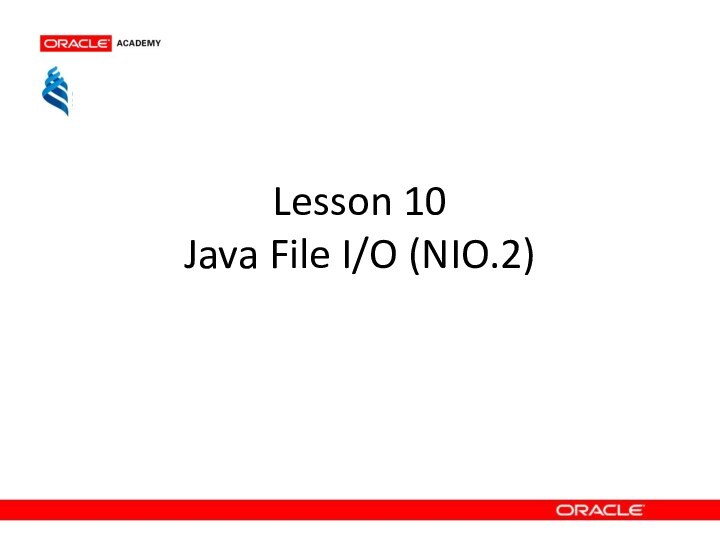

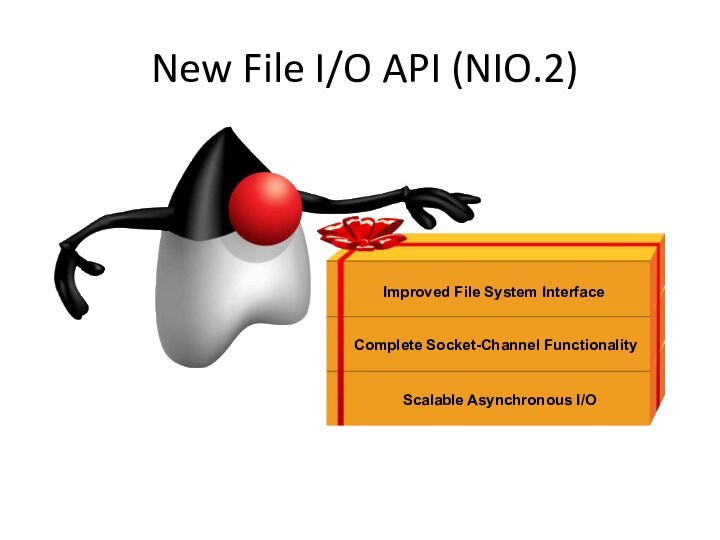

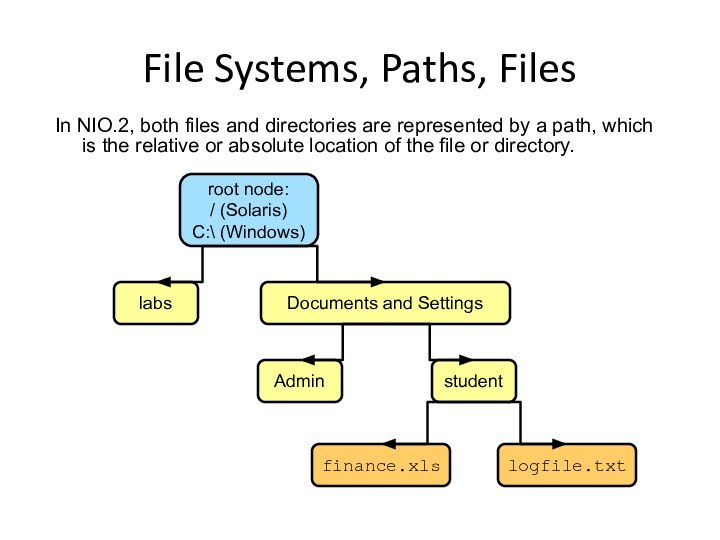





![Java File IO. (Lesson 10) Path: Example public class PathTest public static void main(String[] args)](/img/tmb/15/1446508/b1274f3952b0cf60ab4a9cd73717c8a7-720x.jpg)
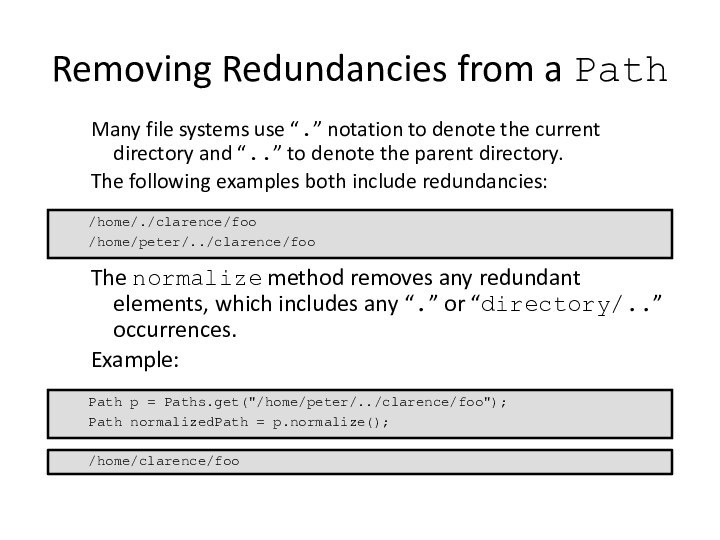










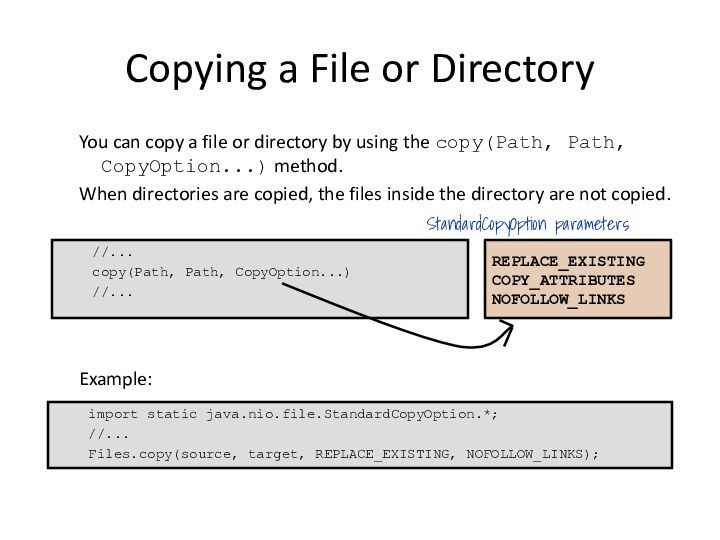







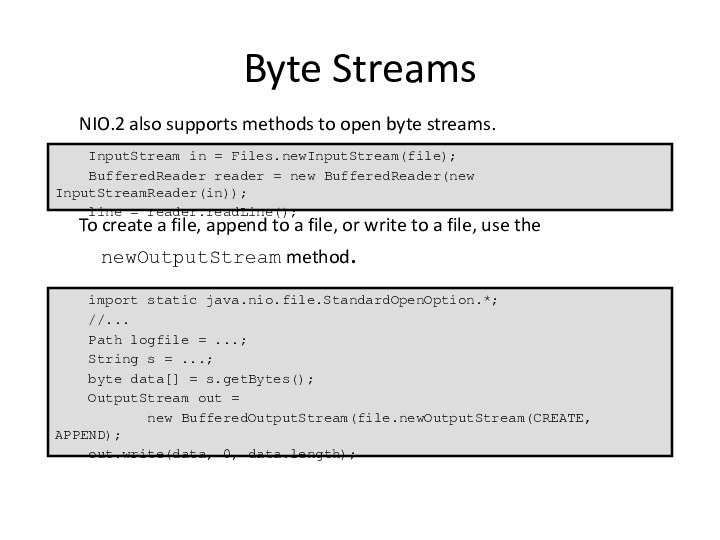


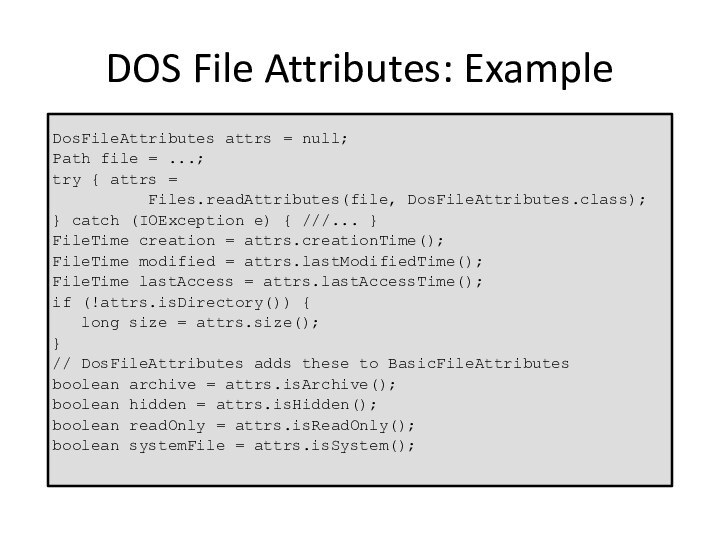


![Java File IO. (Lesson 10) QuizGiven this fragment:Path source = Paths.get(args[0]);Path target = Paths.get(args[1]);Files.copy(source, target);Assuming source and](/img/tmb/15/1446508/edf961bdbd871f8d5edc4af5873d1123-720x.jpg)
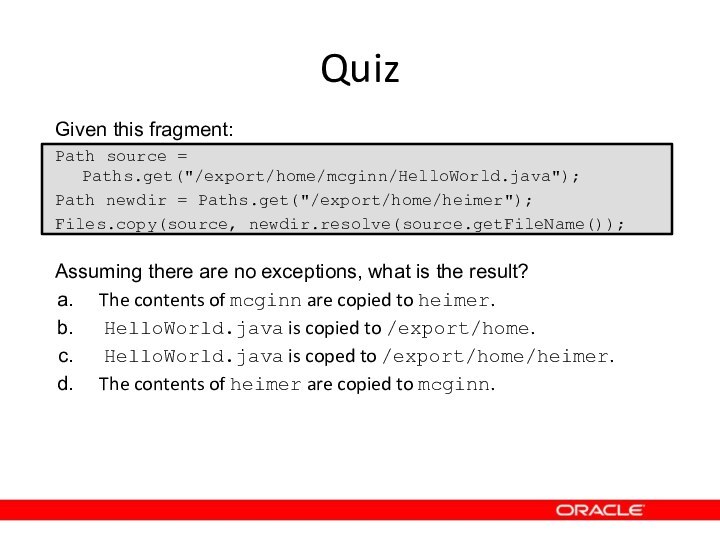







![Java File IO. (Lesson 10) PathMatcher: Example public static void main(String[] args) { // ...](/img/tmb/15/1446508/026ac3c71a16dda39c89f042cc3f0342-720x.jpg)




